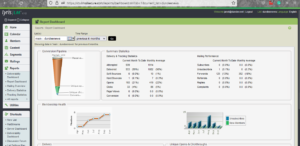You Too Can Experience Successful Email Delivery Using Optimization
Email content that looks great but doesn’t reach its intended recipients cannot be called a successful email delivery. In this anti-spam climate, it is necessary to optimize your messages to reach this goal.
The goal of a successful email delivery starts with a great sending mechanism: either a dedicated software application or working with an Email Service Provider (ESP).
Most ESP’s provide list management, saving administrative time for the email marketer by providing manageable subscriber information, including membership behavior, list organization, and subscriber verification.
The next component for successful email delivery is creating complete and consistent email headers for sent messages. The important elements that the sender controls include the FROM, TO, and Subject fields. These fields are normally analyzed by the receiving mail servers, using automated anti-spam filters to protect individual email boxes from unwanted email.
Email header fields need to be clear and consistent. For example, when sending messages from your business, i.e. ABC Cat & Calico, that business name would in the header of every email campaign along with a valid FROM address. Being consistent will encourage list members to “white list” email from your FROM address. (Also note if you offer a reply option in your message, use a valid email address).
Following industry email header standards, include the recipient’s name with their email address in the TO field. (i.e., pat@dundee.net).
Lastly, the Subject Line should be accurate and compelling. Accuracy is key. You might include a special Subject prefix in each mailing that easily identifies the messages as your newsletter. In addition, using a prefix will help bypass spam filters. For example, an email newsletter adds the prefix (The Cat & Calico) to the Subject line, will be readily identified in a recipient’s inbox.
Email newsletters from legitimate, permission-based publishers or marketers, have substantive content to share with their email members. Content that has a balance of text, graphics, and links, following the Best Practices for email is a must for successful email delivery.
The final step includes testing your messages for delivery and best response from your audience. Consider using seed addresses by signing up to the major ISP’s free email programs. These would include AOL, Hotmail, Gmail, Yahoo and so forth. Put your seed addresses on the test list and verify the message is delivered to your inbox.
When the message is delivered to your inbox (per service) it’s a good sign that that there will be a successful email delivery to your list members. When the message is automatically routed to the spam, junk or delete folder, reevaluate, and edit the headers, and content. And test again. Verify the issue isn’t with your ESP causing the wrong result.
Sometimes, even with your best efforts, the recipient may never see your message. ISPs are in the business of delivering email that people want. Therefore, make sure your email is something your customers want. When the content is interesting and relevant every time, recipients are unlikely to report you as a spammer. In fact, they are more likely to miss reading your messages if they are being automatically moved to the spam filter or deleted by the receiving email server.
Most service providers (ESPs) provide good delivery reports, which include detailed information about why your mail is not getting through. An ESP will work with you to resolve these delivery issues when possible.
Successful email delivery can be quite a challenge, and it’s often a moving target when trying to proactively address the issues that arise. However, if you consistently follow Best Practices, you will find the challenges of deliverability to be not quite the problem they once were.




Comments
Post a Comment